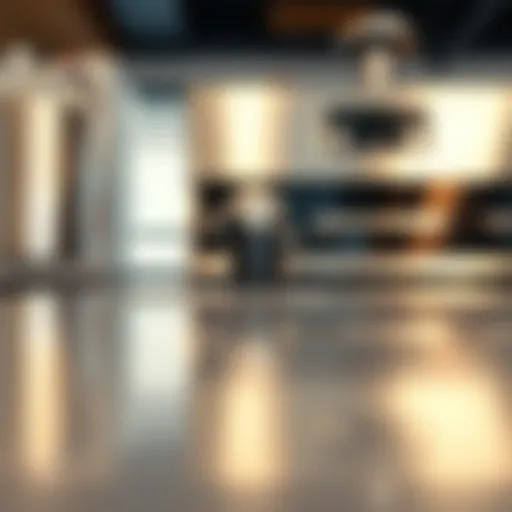Expert Tips for Cleaning Stainless Steel Refrigerators


Intro
Keeping a stainless steel refrigerator looking sharp is no small feat. With its shiny surface, this kitchen centerpiece can quickly fall victim to fingerprints, smudges, and dust. Besides being unsightly, neglecting regular cleaning can shorten its lifespan. The good news? A well-executed cleaning routine can transform your appliance without breaking a sweat.
In this guide, we’ll cover the nitty-gritty of cleaning your stainless steel refrigerator—from effective techniques to the best products to use. By the end of this article, you’ll have a treasure trove of knowledge to keep your fridge sparkling and your kitchen looking chic. The goal is not just to enhance aesthetic appeal but also to ensure functionality remains in tip-top shape.
Prologue to Stainless Steel Refrigerators
When it comes to modern kitchens, stainless steel refrigerators often steal the spotlight. Their sleek, shiny appearance coupled with durability makes them a staple in many homes. The aesthetics of stainless steel play a crucial role in elevating the overall ambiance of the kitchen. But that’s not all; these refrigerators offer a myriad of benefits beyond just looks.
One key aspect to understand is how stainless steel appliances resist corrosion and wear. Unlike other materials, stainless steel can withstand the rigors of everyday life, whether it be kitchen spills, high humidity, or temperature changes. This resilience translates into a longer lifespan and elongates the time between needing replacements or costly repairs.
Moreover, the energy efficiency of stainless steel refrigerators contributes greatly to their appeal. Many models come equipped with advanced technology that not only keeps your food fresh but also minimizes energy consumption. This not only benefits the environment but also helps in lowering your utility bills.
Now, it’s important to note that while stainless steel appliances may seem low maintenance, they still need regular care to maintain that sleek finish. Fingerprints, smudges, and streaks can dampen the appeal of even the finest stainless steel. Thus, knowing how to properly clean and maintain these refrigerators becomes essential. This guide will equip you with the knowledge and techniques necessary to shine and extend the life of your appliance.
In summary, choosing a stainless steel refrigerator is more than just an aesthetic decision; it’s about investing in durability, efficiency, and style. With the right care, your stainless steel appliance can be an enduring symbol of elegance in your kitchen. And that’s what we’ll dive into throughout this comprehensive guide.
Understanding Stainless Steel Finishes
When it comes to maintaining the aesthetic appeal of stainless steel refrigerators, grasping the nuances behind finishes is essential. Finishes not only contribute to the overall look of the appliance but also affect its maintenance and longevity. Selecting the right finish can mean the difference between a refrigerator that gleams and one that appears dull and lifeless due to everyday wear and tear.
Different finishes have unique characteristics that come into play, influencing factors such as how easily they attract fingerprints, resist scratches, or show streaks when cleaned. Understanding these distinct elements allows homeowners to make informed decisions about cleaning methods and routine upkeep. Additionally, some finishes may require specific types of cleaning solutions or tools that can enhance their appearance without causing damage.
In this section, we will delve deeper into the types of stainless steel surfaces available and explore the differences between brushed and polished finishes. By understanding these differences, you’ll not only uphold the charm of your kitchen but also maintain the functionality of your appliance.
Types of Stainless Steel Surfaces
Stainless steel surfaces can be broadly categorized into two types: brushed and polished. These surface types are distinguished by their texture and reflectivity, both of which have considerable implications for cleaning and maintenance.
Brushed Finish: A brushed stainless steel surface features a textured feel. This finish is achieved through a mechanical polishing process, which leaves fine lines running in one direction. This texture helps to mask fingerprints and small scratches, making it a preferred choice for many homeowners who appreciate a more rugged appearance and lower maintenance.
Polished Finish: On the flip side, the polished finish offers a smooth and highly reflective surface. It shines brilliantly under lights and gives a sleek, modern look. However, the downside is that it tends to show fingerprints, smudges, and streaks more readily. Maintaining this finish may require a bit more effort to keep it looking pristine compared to its brushed counterpart.
In short, the choice between brushed and polished stainless steel often comes down to personal preference and lifestyle. If you’re the type who loves hosting weekend barbecues, a brushed finish may be the ideal option. For those who enjoy a high-gloss kitchen aesthetic, a polished finish could be just what the doctor ordered.
Brushed vs. Polished Finishes
The debate over brushed versus polished finishes is one often heard in interior design circles. Each has distinct characteristics that make it suitable for different personalities and settings.
- Maintenance: Brushed finishes require less frequent cleaning as they are less likely to show fingerprints. When smudges do occur, they can often be wiped away with a simple microfiber cloth. Polished finishes, on the other hand, may need more care and caution when cleaning. Using the wrong cleaning agents or rough cloths can lead to scratches or dull the shine.
- Aesthetic Appeal: A polished finish exudes elegance and sophistication, making it a great choice for modern kitchens. However, brushed finishes offer a more industrial or rustic look that fits beautifully in farmhouse or contemporary settings.
- Durability: While both finishes are durable, brushed stainless steel generally has an advantage when it comes to hiding imperfections. The textured surface can soften the impact of accidental scrapes and scratches that may occur during everyday use.
Important Note: When contemplating which finish works best for your stainless steel appliance, consider not just style and appearance, but also how much time you are willing to commit to maintenance over the lifespan of the appliance.
Tools and Materials Required
Keeping your stainless steel refrigerator in prime condition requires more than just elbow grease; it demands the right tools and cleaning formulations. The tools and materials you gather not only streamline your cleaning process but also help maintain the appliance’s luster and functionality over the long haul. This section will outline the essentials needed to achieve that polished shine and protect your investment from everyday wear and tear.
Essential Cleaning Tools
When it comes to cleaning stainless steel, the choice of tools can make or break the outcome. Here are some must-have tools that make the task effective:
- Microfiber Cloths: These are the unsung heroes of cleaning. Microfiber cloths trap dirt and grease without scratching the surface, making them ideal for stainless steel. Opt for both dry and damp cloths for varied tasks.
- Soft-bristle Brush: For those hard-to-reach areas, a soft-bristle brush can be invaluable. It helps loosen grime without scratching.
- Spray Bottle: A spray bottle is handy for both your cleaning solutions and water. Keeping this filled lets you easily apply your chosen cleaner where it’s needed most.
- Sponge or Non-abrasive Scouring Pads: For more tenacious stains, a gentle sponge or pad can be useful without damaging the stainless steel finish.
- Cleaning Gloves: Protect your hands during the cleaning process with a good pair of gloves. Some cleaning agents can be harsh on skin.
Each tool serves a purpose, and having them at your fingertips not only saves time but ensures a thorough clean.
Recommended Cleaning Solutions
The cleaning solution you choose can significantly affect the outcome. A well-chosen cleaner can lift dirt, grease, and stains, leaving surfaces gleaming. Here are recommended solutions specific to stainless steel:


- Vinegar and Water Mixture: A simple yet effective solution. Mix equal parts of vinegar and water in a spray bottle. Vinegar is a natural cleaner that cuts through grease and gives a streak-free shine.
- Olive Oil: While it might seem odd, a few drops of olive oil on a cloth can work wonders for polishing stainless steel. It helps rejuvenate the finish and makes fingerprints less noticeable.
- Specialty Stainless Steel Cleaners: There are myriad commercial cleaners specifically designed for stainless steel. These often contain ingredients that prevent streaking and enhance the shine. Brands like Weiman and Bar Keepers Friend offer reliable options.
- Baking Soda Paste: For marked areas, a paste made from baking soda and water can be extremely effective. It should be applied gently with a sponge and rinsed thoroughly afterward.
Remember to always test any cleaning solution on a small, inconspicuous area before applying it across the entire surface. This helps avoid any unwanted surprises.
"The right tools and cleaners can make your stainless steel shine like new, keeping your kitchen looking fresh!"
In summary, having the right tools and cleaning solutions is the foundation of maintaining your stainless steel refrigerator. Arm yourself with these essentials, and you’ll find the cleaning process is not only thorough but also much more efficient.
Preparation Before Cleaning
Before diving into the nitty-gritty of cleaning your stainless steel refrigerator, it’s vital to take a moment for preparation. Think of it as laying down the tracks before the train rolls in. Skipping this step may lead to a haphazard job, which can ultimately hurt the aesthetic and longevity of your appliance. A well-prepared approach makes the entire cleaning process smoother and more efficient.
Clearing the Refrigerator
First things first, you need to clear the refrigerator. This involves removing all items, from the leftover Chinese takeout to the half-eaten birthday cake. Yes, that means taking everything out, even the condiments you’ve forgotten about in the back. This step is crucial not just for cleaning; it gives you a chance to assess what needs to be tossed. Not only will this allow you to clean without obstructions, but it’ll also help you regain some valuable space. Remember, a clutter-free fridge is a happy fridge.
- Turn off the refrigerator or unplug it. This might not be a must, but it can prevent any accidental bumps or spills.
- Organize items by category. Consider sorting them out into groups: dairy, meats, vegetables, and items to throw away. It’ll save you time when putting things back.
- Check expiration dates. If something’s been sitting there for ages, it’s time for it to head to the trash. Your future self will thank you for not subjecting it to the dreaded smell of spoiled food later.
Gathering Cleaning Supplies
Now that the fridge is cleared, it’s time to gather your cleaning supplies. This is all about efficiency. Having your tools at the ready will make sure you don’t have to make pit stops during the cleaning process. The last thing you want is to be halfway through wiping down surfaces and realize you’ve run out of your chosen cleaner.
Here’s a checklist of supplies you should consider:
- Microfiber cloths: These are gentle yet effective for capturing dirt and fingerprints without scratching the surface.
- Non-abrasive cleaner: Look for vinegar or specially formulated stainless steel cleaners; they can work wonders without damaging the finish.
- Soft sponge: For tackling stubborn spots without risking scratches.
- Baking soda: A natural and effective stain remover that can work on more difficult spots.
- Bucket: Useful for collecting any waste, like empty containers or trash from expired items.
When you pull everything together beforehand, it creates a focused cleaning experience. This step ensures you can give your refrigerator the deep clean it deserves, ultimately preserving its shiny exterior and functionality. Rushing through because you forgot the essentials is a surefire way to overlook details that could lead to future dissatisfaction.
A well-prepared workspace not only enhances efficiency but also improves the quality of your cleaning efforts.
Cleaning the Exterior Surface
When it comes to maintaining your stainless steel refrigerator, cleaning the exterior surface is paramount. Not only does it contribute to the overall appearance of your kitchen, but it also extends the life of your appliance. A clean, shining exterior can enhance the aesthetic appeal of your home and reflects your attention to detail. It’s not just about wiping it down; using the correct techniques and products ensures that you’re preserving that sleek finish that makes stainless steel stand out.
Step-by-Step Cleaning Process
Cleaning the exterior of your stainless steel refrigerator doesn’t have to be a chore. Here’s a straightforward process to get you started:
- Gather Your Supplies: Collect all necessary cleaning materials. This includes a microfiber cloth, a gentle cleaning solution, and possibly a soft sponge.
- Preliminary Wipe Down: Using a dry microfiber cloth, wipe the surface to remove loose dust and particles. This step is essential to prevent scratching during deeper cleaning.
- Apply Cleaning Solution: Lightly spray your chosen cleaner onto a clean cloth, instead of spraying directly onto the fridge to avoid excess moisture.
- Wipe: Begin wiping the refrigerator’s surface in the direction of the grain. This helps to avoid streaks and shows you’re really caring for your appliance.
- Rinse and Dry: If your cleaner requires rinsing, do so with a damp cloth. Then immediately dry the surface to avoid water spots.
That's all there is to it! Following these steps keeps your stainless steel looking brand new.
Removing Fingerprints and Smudges
Fingerprints and smudges are almost a rite of passage for any stainless steel appliance. They can be particularly challenging to deal with given how noticeable they can be on the shiny surface. Here’s a simple method to tackle those pesky marks:
- Use Vinegar or Specialized Cleaner: A mixture of equal parts white vinegar and water can do wonders. Alternatively, opt for cleaners specifically designed for stainless steel.
- Microfiber Cloth: Utilize a clean microfiber cloth; its texture works well to lift grime without scratching.
- Spot Treatment: Dab the soiled area with the cloth and gently rub. You'd be surprised at how quickly the fingerprints disappear.
This focused approach not only ensures cleanliness but also keeps your appliance looking polished and presentable.
Dealing with Streaks
Streaks can be a real nuisance when cleaning stainless steel. They can stem from a variety of sources, including improper cleaning techniques or leftover residues from cleaning agents. To resolve this issue, consider these steps:
- Use a Glass Cleaner: Glass cleaners can sometimes work their magic when directed at stainless steel. Just make sure they are ammonia-free to prevent damage.
- Buff with a Dry Cloth: Once you've applied the cleaner, use a dry, soft cloth to buff the surface. This not only eliminates the streak but also restores luster.
- Direction Matters: Always remember to wipe in the direction of the grain; this minimizes streaking and keeps your finish pristine.
“Choosing the right product and method can turn a routine clean into a meticulous maintainance experience.”
By implementing these methods, you can effectively keep streaks at bay, maintaining that smooth, appealing exterior of your stainless steel refrigerator.


Cleaning the Interior
Keeping the interior of your stainless steel refrigerator clean is crucial for both hygiene and functionality. Over time, food spills and crumbs can accumulate, leading to unpleasant odors and even attracting pests. Regular cleaning helps maintain a healthy environment for your food, ensuring that everything stored inside stays fresh. More than just aesthetic value, a well-maintained refrigerator can enhance the overall performance of the appliance, extending its lifespan.
Removing Interior Components
To start the cleaning process, it’s essential to remove all interior components. This includes shelves, drawers, and any additional parts that are removable. Not only does this provide you with access to hard-to-reach areas, but it also allows for a thorough clean without any obstacles in the way. Make sure to take note of how everything is arranged before you begin the removal process.
- Unplug the refrigerator: This is a crucial safety step that should never be overlooked. Turning off your appliance ensures that you can clean without the risk of electric shock.
- Take out shelves and drawers: Depending on the design of your refrigerator, most shelves can be easily lifted out. Drawers should slide out without much resistance. Clean these components in the sink with warm, soapy water.
- Check for damage: While components are out, inspect them for cracks or breaks. Damaged parts can impact the storage capabilities and aesthetic of your fridge.
Wiping Down Shelves and Drawers
After you have removed the individual components, it’s time to wipe down the shelves and drawers thoroughly. Use a soft cloth or sponge along with a gentle cleaning solution, as harsh chemicals might tarnish the stainless steel finish.
- Prepare your cleaning solution: This can be a mixture of warm water and a few drops of dish soap or a dedicated stainless steel cleaner if you have it handy.
- Wipe each surface: Focus on one area at a time, ensuring you get into all corners and crevices. A circular motion often helps in lifting grime.
- Rinse and dry: After wiping down, rinse with clean water to remove any soap residue and then dry completely to prevent streaks.
Deep Cleaning the Crisper Drawers
Crisper drawers often carry a significant amount of moisture and can harbor unpleasant odors and build-up. Cleaning these thoroughly is vital not only for hygiene but for keeping fruits and vegetables fresh longer.
- Empty crisper drawers: Remove all contents and check for expired items.
- Soak in warm, soapy water: Allow these drawers to soak to loosen up any stuck dirt.
- Scrub gently: Use a soft brush or cloth and scrub off any remaining residues. This will also help remove stubborn stains.
- Rinse and sanitize: Rinse well after scrubbing, then use a mixture of vinegar and water to sanitize. A final rinse with clean water is a must!
In summary, maintaining the interior of your stainless steel refrigerator requires attention to detail but pays off in terms of cleanliness and functionality. By replacing components in their original spots after cleaning, you can keep yours looking sharp and running smoothly for a long time.
"A clean refrigerator is more than just a luxury; it's a necessity for any kitchen."
Incorporating these cleaning practices into your routine will help you preserve that shiny new look of stainless steel while ensuring your food stays fresh and free of any strange odors.
Addressing Stains and Marks
Cleaning a stainless steel refrigerator goes beyond a mere swipe with a cloth. Stains and marks can quickly tarnish its elegant look, making your appliance appear dated and cluttered. Understanding how to address these blemishes is essential for maintaining not just cleanliness but also the aesthetic appeal of your kitchen. Keeping surfaces spotless can enhance your home’s overall presentation, an important aspect that property enthusiasts greatly appreciate.
When grime sets in, the shiny surface of stainless steel is less resilient than one might think. It’s important to recognize that certain substances and residues can leave more than just temporary marks; they can seriously mar the finish if not treated promptly. This section delves into common types of stains you might encounter and effective techniques for removal.
Common Types of Stains
Stains on stainless steel come in various forms, often indicating the source of the problem. Here’s a breakdown of common types:
- Food Residue: Spills from cooking, especially oils and sauces, can dry and become difficult to remove. They often leave a sticky residue.
- Water Spots: Hard water can leave unsightly spots that accumulate over time, especially in humid kitchens.
- Fingerprints and Smudges: These are perhaps the most frequent offenders, often showing up right after a quick grab for a snack.
- Rust Stains: Occasionally, metal utensils or cookware can transfer rusting onto the surface, giving it a reddish tint.
- Dirt and Dust: Over time, accumulated dust and dirt can blend with moisture, forming marks that are unsightly.
Techniques for Stain Removal
Now that we've identified the potential culprits, let’s discuss methods to effectively tackle these stains.
- Use Mild Detergents: For food residues and general grime, a mixture of mild detergent and warm water is often all you need. Applying with a soft cloth, you can wipe the surface without scratching it.
- Vinegar and Water: A 50/50 solution of vinegar and water can tackle water spots effectively. Spray it directly on the affected area and wipe with a microfiber cloth. This natural solution not only shines but also disinfects.
- Baking Soda Paste: For stubborn stains, create a paste using baking soda and water. Apply the paste on the stain, let it sit for a while, and scrub gently with a soft brush to remove the mark without damaging the surface.
- Oil for Fingerprints: Surprisingly, mineral oil or baby oil can work wonders. A few drops applied with a soft cloth can buff out those pesky finger smudges and leave a protective sheen.
- Rust Removal Solutions: For rust stains, specifically formulated stainless steel cleaners can break down the rust without harming the finish. Apply according to product instructions, generally involving a soft cloth for application.
Tip: Always test a small, inconspicuous area first when using any cleaning agent to avoid unexpected reactions.
Maintaining the sleek appearance of your stainless steel refrigerator might take a bit of effort, but the results are well worth it. By effectively addressing stains and marks, not only do you preserve the device's beauty but also ensure its longevity. Regular upkeep can spin breaking out the elbow grease into an art form, making your kitchen space feel more welcoming and polished.
Preventive Maintenance Tips
When it comes to extending the lifespan and maintaining the aesthetic of your stainless steel refrigerator, preventive maintenance plays a pivotal role. It’s not just about cleaning the appliance now and then; it’s about creating habits that keep it looking pristine and operating efficiently over the long haul. Simple, consistent actions can save you from the hassle of needing extensive repairs down the road.
Benefits of Preventive Maintenance
Preventive maintenance doesn’t just enhance the appearance of your refrigerator; it also adds to its functionality. Here are some key benefits:
- Cost Efficiency: Regular upkeep can reduce the need for expensive repairs. A cleaner fridge uses less energy, which could slightly lower your utility bills.
- Enhanced Longevity: Stainless steel appliances are designed to last, but neglect can lead to deterioration. Regular maintenance keeps your fridge running well for years.
- Improved Hygiene: A well-maintained refrigerator is less prone to bacteria or mold build-up, making it safer for food storage.
- Aesthetic Appeal: Maintaining the shine and finish of the stainless steel gives your kitchen an overall polished feel.
With these benefits in mind, let’s dive into some practical tips that will help you keep your stainless steel refrigerator in tip-top shape.


Establishing a Regular Cleaning Routine
Creating a cleaning schedule is essential. Think of it like tending to a garden – if you give it regular attention, it flourishes.
- Frequency: Aim for a complete clean every 1-2 months, depending on your household's needs and usage. Daily spot cleaning can help manage fingerprints and surface smudges.
- Checklist: Create a cleaning checklist. Include task like wiping surfaces, cleaning handles, and organizing shelves. Sometimes, visual prompts can help you stay on track.
- Reminders: Set calendar reminders or use apps to schedule your cleaning days. This takes the guesswork out of when to clean and ensures consistency.
Developing a habit of routine care will pay off in making cleaning less daunting, as well as ensuring your appliance remains a centerpiece of your kitchen.
Using Protective Coatings
Applying protective coatings can be like putting on sunscreen before hitting the beach – it prevents damage brought on by environmental factors.
- Types of Coatings: Several products are available on the market specifically designed for stainless steel surfaces. They create a barrier that repels dirt and stains.
- Application Tips: Before applying, make sure the surface is thoroughly clean. Read product instructions carefully to understand application methods and drying times. Generally, a microfiber cloth works wonders for applying these coatings evenly.
- Frequency: Consider reapplying these coatings every few months, or as specified by the product. Frequent use can wear down the protective layer, so it’s crucial to stay ahead of the game.
Using protective coatings will not only keep your fridge looking brand-new but also make subsequent cleaning sessions much easier.
Remember: An ounce of prevention is worth a pound of cure. Regular attention can keep your refrigerator shining bright and running at its best.
By tying these preventive maintenance tips together, you can cultivate a space that feels clean and inviting and maintain the operational integrity of your stainless steel refrigerator. Engage in a regular cleaning routine and don’t forget to utilize protective coatings to reap the full benefits of preventive upkeep.
Common Mistakes to Avoid
When it comes to cleaning stainless steel refrigerators, avoiding common pitfalls can make the difference between maintaining a sleek, polished look and ending up with an unsatisfactory finish. These mistakes can lead to more hassle in the long run, and can even cause damage to the appliance. Therefore, knowing what to steer clear of is essential. Here’s a dive into two significant mistakes that many people make when caring for their appliances.
Incorrect Cleaning Agents
One of the most frequent errors is using the wrong kind of cleaning products. Not all cleaning agents are created equal, and certain ones can wreak havoc on the surface of stainless steel. Products containing bleach or ammonia may seem like they would cut through grime effectively; however, they can actually dull the finish of the stainless steel and degrade its protective layer.
Instead of these harsh chemicals, look for pH-balanced cleaners made specifically for stainless steel. Here are a few tips for selecting the right products:
- Read the Labels: Always check the labels for suitability on stainless steel.
- Natural Alternatives: Consider mixing vinegar and water as a gentle cleaning solution—this can handle smudges without damage.
- Avoid Scrubbing Pads: Abrasive pads can scratch the surface; opt for microfiber cloths instead.
By recognizing the need for appropriate cleaning solutions, you can not only avoid damage but also enhance the appliance's durability and shine.
Neglecting to Dry Properly
After cleaning, many folks simply wipe down their stainless steel fridge and leave it. This can be another costly mistake. Failing to dry the surface properly can result in streaks, and over time, it may lead to water spots.
The importance of drying lies in several key reasons:
- Prevent Streaks: Moisture left on the surface often dries unevenly, leading to the unsightly streaks that can be hard to remove later.
- Discourage Residue Build-Up: Water can attract dust and grime when it evaporates, which can lead to your appliance looking dirtier faster.
- Maintain the Finish: Frequent bathing in moisture can slowly degrade the finish of the stainless steel, so it’s wise to invest a little more time in drying.
To properly dry your refrigerator after cleaning:
- Use a soft, dry cloth to gently wipe down every surface.
- Follow up with a second cloth in circular motions for a polished shine.
By addressing these common mistakes, you can ensure that your stainless steel refrigerator remains a beautiful and functional focal point of your kitchen.
Closure
In wrapping up this comprehensive guide, it's vital to highlight the key takeaways regarding the cleaning and maintenance of stainless steel refrigerators. This is not just about spiffing up your appliance to make it look shiny; it’s about preserving its integrity and maximizing its lifespan. With proper care, your fridge can gleam like new for years, reflecting not just a high aesthetic standard but also enhancing the overall appeal of your kitchen space.
First and foremost, readers should recognize that routine cleaning is essential. Establishing a regular maintenance schedule is a no-brainer for avoiding buildup of dirt and grime. It’s like giving your refrigerator a spa day; keep it fresh and in top form. Without it, you'd end up spending more time—with more effort—wrestling with stubborn stains and marks that could have easily been prevented.
Moreover, understanding the specific cleaning agents and tools suitable for stainless steel is crucial. Using incorrect solutions might not only fail at cleaning but could also harm the surface, leading to tarnishing or scratches. Read the labels and stick to cleaners designed for stainless steel to keep your appliance looking sleek and sharp.
Another significant point is the attention to detail when cleaning, especially around the corners and seals. It often goes unnoticed but neglecting these areas can lead to mold or mildew—an easy pitfall for those who clean hastily. Addressing every nook and cranny pays off in the long run.
In addition, when you incorporate preventive measures like using protective coatings, you’re giving yourself an upper hand against dirt accumulation and potential damage—the logical choice, isn't it? Just a small effort here can save heaps of time and keep the aesthetic intact.
While it may seem like a simple task—cleaning a stainless steel refrigerator—it holds considerable weight in terms of home care. A sparkling, well-maintained appliance reflects your dedication to home upkeep and can really enhance your kitchen's aesthetic and functionality in a significant way.
"A clean kitchen appliance not only shines but adds to the charisma of your kitchen, often making it the star of the show."
Following these insights not only makes the process more efficient but encourages an overall culture of cleanliness within the home. Your refrigerator deserves attention, and with this guide, you're more than equipped to keep it looking the way it should—impeccable!







